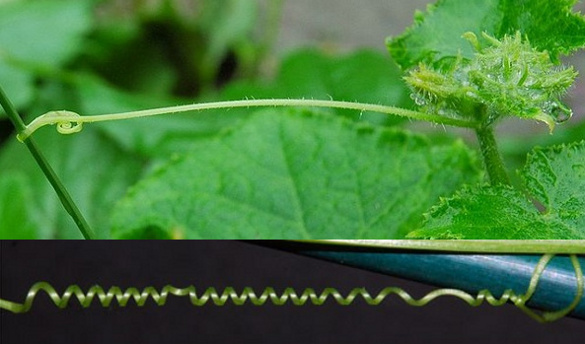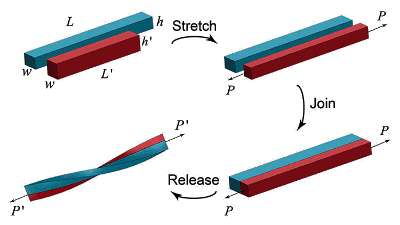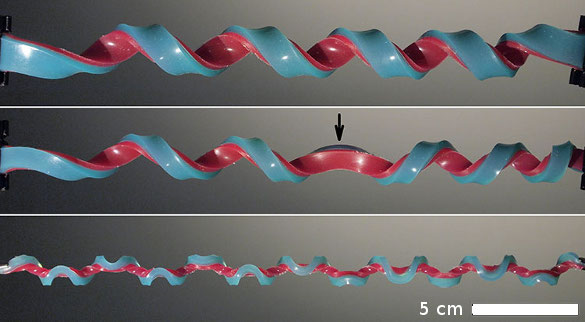Let's Do The Twist
May 9, 2014
Children of
Baby Boomers can easily embarrass their
parents by asking them to demonstrate the
novelty dance of their era, the
Twist (not recommended for
hip-replacement recipients). This dance was popularized in 1960 by a
recording of the same name by
Chubby Checker; and, unlike
ballroom dances, it was easy enough to be learned by
elementary school students, thus its popularity.
Twist is an important feature in many
natural systems and artificial devices. A retired
colleague of mine has been
publishing scientific studies of the energy efficiency of twisted rubbers used for propulsion of model airplanes. I wrote about the twisting
tendrils of cucumbers and squash in a
previous article (Twisty Cucumbers, All Alike, September 7, 2012). These tendrils are used to draw the these plants upwards through formation of a
spiral/
helical structure (see photograph).

Tendrils of the cucumber plant, Cucumis sativus. In the top image, the tendril has just grasped an object and it hasn't formed the dual helix structure. The dual helix structure is shown in the lower image. (Top image by Kropsoq, via Wikimedia Commons. Lower image, Harvard SEAS image by Joshua Puzey and Sharon Gerbode).[1)]
As can be seen in the photograph, the structure of the twist is unusual. There's a
right hand helix on one end, and a
left hand helix on the other. In the center, there's a transitional region, called a called a "perversion," a word derived from the
Latin adjective, "perversus," which means slanted, crooked, or cross-eyed. This structure was noted by
Charles Darwin in 1865.
These tendrils are soft
springs when gently pulled, but they become stiff springs when pulled hard. A
stressed cucumber tendril doesn't unwind into a flat ribbon; rather, it coils further.[1] In 2012, the twist motor of these tendrils was reproduced in an artificial material structure by a research team led by
scientists from the
Harvard University's School of Engineering and Applied Sciences.[2]
They
mimicked this mechanical structure by
gluing a
fabric ribbon to one side of a
silicone ribbon and a
copper wire to the other side. The apparent key to the design is that the
bending stiffness of the ribbon is higher than the twisting stiffness, so it's easier to axially twist the ribbon than to bend it.[1] A
patent application has been filed on this technology.[3]
Further work on this topic has been published by other researchers at the Harvard School of Engineering and Applied Sciences.[4-8]
David R. Clarke, a
materials scientist,
Katia Bertoldi, an
associate professor of
applied mechanics,
Jiangshui Huang, a
postdoctoral research associate in Clarke's group,
Jia Liu, a
graduate student in Bertoldi's group, and
Tianxiang Su, a former postdoctoral associate in Bertoldi's group, have just published an
open access paper in
PLoS One describing a hemihelical twist structure that doesn't appear in
nature.[4]
In their
experiments, the research team was attempting to make
two-dimensional springs by bonding two elastomer strips of different
lengths after first stretching the shorter one to reach the same length as the longer one. They expected that this composite would curl into a
scroll. I would have expected the same. Instead, they got a hemihelix with multiple transitions (perversions) from one twist direction to the other. The process used to form the composite strip is shown in the figure.[5]

To create the twist composite, the shorter elastomer strip is stretched by a force P and joined to the longer strip. When the stretching force is slowly released, the bi-strip twists into a helix or a hemihelix.
(Harvard University image by Jia Liu.)
To analyze the conditions under which hemihelices would form, the research team tried different
width-to-height aspect ratios of the elastomer strips. They found that when a strip is very wide relative to its height, a helix is formed, and there's a critical aspect ratio at which a hemihelix will form.[5] What's interesting about this discovery is that other
materials will
rupture when subjected to the mismatch
strain induced in forming the composite, and that's why this effect has not been observed previously.[5-6]
Says study coauthor, Katia Bertoldi, "Once you are able to fabricate these complex shapes and control them, the next step will be to see if they have unusual properties; for example, to look at their effect on the propagation of
light."[5] This effect is reproducible, so novel
sensors,
resonators, and
electromagnetic wave absorbers might be built.[5] As Jia Liu explains,
"We see deterministic growth from a two-dimensional state—two strips bonded together—to a three-dimensional state... The actual number of perversions, the diameter, everything else about it is entirely prescribed. There is no randomness; it's fully deterministic. So if you make one hundred of these, they'll always perform exactly the same way."[5]

Top image, a simple helix; middle image, a hemihelix with one perversion marked by an arrow; and, bottom image, a hemihelix with multiple perversions. The scale bar of 5 centimeters is valid for all images. (Harvard University image by Jiangshui Huang.)
This research was supported in part by the
Harvard Materials Research Science and Engineering Center, which is supported by the
National Science Foundation.[4-5]
References:
- Uncoiling the cucumber's enigma, Harvard School of Engineering and Applied Sciences Press Release, August 30, 2012.
- Sharon J. Gerbode, Joshua R. Puzey, Andrew G. McCormick and L. Mahadevan, "How the Cucumber Tendril Coils and Overwinds," Science, vol. 337 no. 6098 (August 31, 2012), pp. 1087-1091.
- Lakshminarayanan Mahadevan, Sharon J. Gerbode, Joshua R. Puzey and Andrew Mccormick, "A twistless overwinding spring," PCT Patent Application No. WO2013130707 A1, Feb 28, 2013.
- Jia Liu, Jiangshui Huang, Tianxiang Su, Katia Bertoldi and David R. Clarke, "Structural Transition from Helices to Hemihelices, PLoS ONE, Document No. e93183, April 23, 2014, DOI: 10.1371/journal.pone.0093183 (Open Access Article).
- Paul Karoff, "Scientists characterize a new shape using rubber bands," Harvard School of Engineering and Applied Sciences Press Release, April 23, 2014.
- Thomas Sumner, "Video: New Shape Born From Rubber Bands," Science, April 23, 2014.
- Structural Transition from Helices to Hemihelices - Videos.
- Supplementary Material for Ref. 4 (PDF File).
Permanent Link to this article
Linked Keywords: Child; Children; Baby Boomer; parent; novelty dance; The Twist; hip-replacement; record - single; recording; Chubby Checker; ballroom dance; elementary school; student; twist; natural systems; colleague; scientific literature; publishing scientific studies; tendril; spiral; helix; helical; Wikimedia Commons; Joshua Puzey; Sharon Gerbode; right-hand rule; left hand rule; Latin; adjective; Charles Darwin; spring; stress; scientist; Harvard University; School of Engineering and Applied Sciences; biomimicry; mimic; adhesive; glue; fabric; silicone rubber; silicone; copper; wire; bending stiffness; patent application; David R. Clarke; materials scientist; Katia Bertoldi; associate professor; applied mechanics; Jiangshui Huang; postdoctoral research; Jia Liu; postgraduate education; graduate student; Tianxiang Su; open access journal; PLoS One; nature; experiment; two-dimensional; spring; length; scroll; width-to-height aspect ratio; material; fracture; rupture; strain; light; sensor; resonance; resonators; electromagnetic wave absorber; three-dimensional; diameter; randomness; deterministic; centimeter; Lakshminarayanan Mahadevan, Sharon J. Gerbode, Joshua R. Puzey and Andrew Mccormick, "A twistless overwinding spring," PCT Patent Application No. WO2013130707 A1, Feb 28, 2013.